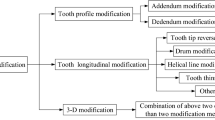Abstract
The design of tooth surface for low gear noise under various load conditions is very important, and gear noise is highly related to transmission error. Optimal tooth surface for reduction of transmission error is very difficult to analytically determine due to nonlinearity of transmission error and the need to satisfy multiple load conditions. Satisfying design variables in multiple load conditions leads to the Pareto optimum of multi-objective optimization. There, the method to determine optimal lead curve and robust tooth surface design is proposed, using the response surface method and multi-objective optimization. The effect of transmission error on the candidate design variables by a screening experiment has been investigated using analysis of variance. Design variables are likewise selected. The fitted regression model of transmission error is built with the statistic validation of the representation. The model with constraints is solved to obtain optimum lead curve design and robust design for the tooth surface under multiple loads.
Similar content being viewed by others
References
D. W. Dudley and D. P. Townsend ed., Dudley’s Gear Handbook 2nd ed., Chpt.14, McGraw-Hill, New York, USA, (1996).
T. F. Conry and A. Seireg, A Mathematical Programming Technique for the Evaluation of Load Distribution and Optimal Modifications for Gear Systems, ASME Journal of Engineering for Industry, 95(4) (1973) 1115–1122.
N. Maruyama, K. Inoue, N. Hitomi, I. Nakagawa and K. Morikawa, Optimum Modification of Gear Tooth Surface to Achieve Silent, Tough Automobile Transmissions, Proc. of the 1989 International Power Transmission and Gearing Conference, Chicago, Illinois, USA, (1989) 899–905.
S. Sundaresan, Kisi and D. R. Houser, Design of Helical Gears with Minimum Transmission Error under Manufacturing and Operating Variances, Proc. of the International Conference on Motion and Power Transmission(MPT’91), Hiroshima, Japan, (1991) 92–97.
M. Umeyama, Effects of Modified Tooth Surface of a Helical Gear Pair on the Transmission Error and its Optimal Design, Proc. of International Gearing Conference, University of Newcastle, Tyne, UK (1994) 377–382.
M. Umeyama, M. Kato and K. Inoue, Effects of Gear Dimensions and Tooth Surface Modifications on the Loaded Transmission Error of a Helical Gear Pair, Trans. of the ASME Journal of Mechanical Design, 120(March) (1998) 119–125.
I. C. Regalado, Application of robustness in the multiobjective optimization of gears, Ph.D dissertation, The Ohio State University (1998).
J. Harianto and D. R. Houser, A Methodology for Obtaining Optimum Gear Tooth Micro-topographies for Noise and Stress Minimization over a Broad Operating Torque Range, Proc. of the 2007 International Power Transmission and Gearing Conference, Las Vegas, Nevada, USA DETC2007-34655, (2007) 1–15.
C. I. Park and D. S. Kim, Transmission Error Analysis of Helical Gears for the Elevator, Trans. of the KSME A, 26(12) (2002) 2695–2702 (in Korean).
K. Umezawa, The Meshing Test on Helical Gears under Load Transmission (1st Report, The Approximate Formula for Deflection of Gear Tooth), Bulletin of the JSME, 15(90) (1972) 1632–1639.
C. Weber, The Deformations of Loaded Gears and the Effects on Their Load-carrying Capacity, Sponsored research (Germany), British Dept. of Scientific and Industrial Research, Report No.3, (1949).
A. Kubo, Stress condition, Vibrational Exciting Force, and Contact Pattern of Helical Gears with Manufacturing and Alignment Errors, Trans. of the ASME Journal of Mechanical Design,, 100 (1978) 177–184.
R. H. Myers and D. C. Montgomery, Response Surface Methodology, 2nd ed., John Wiley & Sons, New York, USA (2002).
Matlab Optimization Tool Box 3 User’s Guide, The Math-Works, (2007).
G. N. Vanderplaats, Numerical Optimization Techniques for Engineering Design, McGraw-Hill, New York USA,, (1984).
D. C. Montgomery, Design and Analysis of Experiments 5th ed., John Wiley & Sons, New York, USA, (2001).
P. Y. Papalambros and D. J. Wilde, Principles of Optimal Design, 2nd ed., Cambridge, UK, (2000).
C. I. Park, Multi-objective Optimization of the Tooth Surface in Helical Gears Using the Response Surface Method, Proc. of the JSME International Conference on Motion and Power Transmissions (MPT2009-Sendai), Matsushima Isles Resort, Japan, (2009) 10–14.
Author information
Authors and Affiliations
Corresponding author
Additional information
This paper was recommended for publication in revised form by Associate Editor Hong Hee Yoo
Chan IL Park, who received a B.S., an M.S., and a Ph.D. in mechanical engineering at Seoul National University, worked at Hyundai Motor Company for eight years. He has held positions as a post-doc. at the University of Michigan in Ann Arbor for one year, a visiting scholar at the Georgia Tech. for one year and Ohio State University, and a dean of the College of Engineering at Kangnung National University for two years. He is a professor in the precision mechanical engineering at Gangneung-wonju National University. His research interests are gear dynamics, plate, shell, optimal design, and acoustics.
Rights and permissions
About this article
Cite this article
Park, C.I. Multi-objective optimization of the tooth surface in helical gears using design of experiment and the response surface method. J Mech Sci Technol 24, 823–829 (2010). https://doi.org/10.1007/s12206-010-0117-x
Received:
Revised:
Accepted:
Published:
Issue Date:
DOI: https://doi.org/10.1007/s12206-010-0117-x




